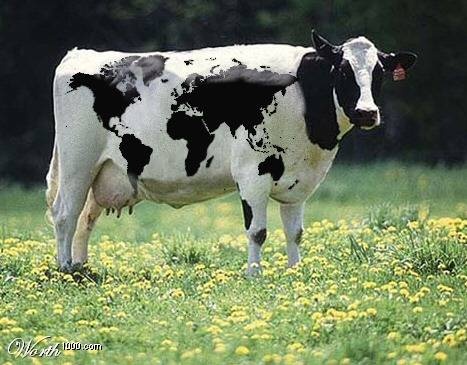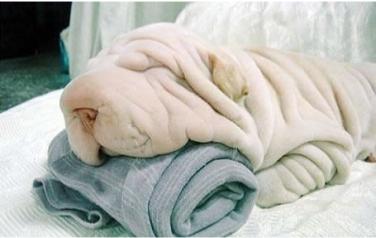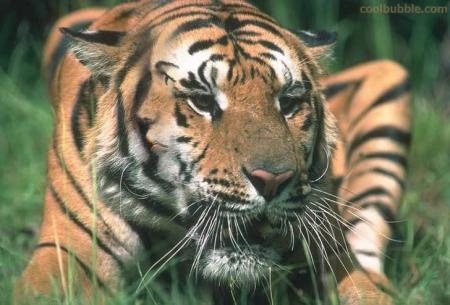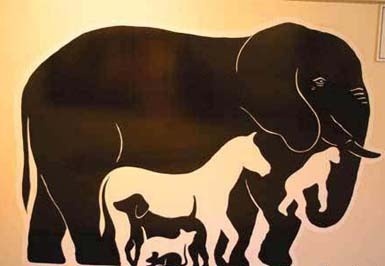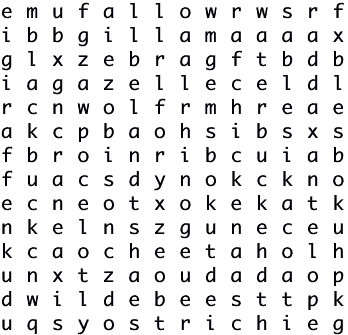1. Which animal does not generally show claw marks in its tracks?
A. Gray Squirrel
B. Mountain Lion
C. Coyote
D. River Otter
2. Which animal does not show five toes in its tracks?
A. Raccoon
B. Bobcat
C. Black Bear
D. River Otter
3. Which animal does not have webbing on its feet?
A. Duck
B. River otter
C. Muskrat
D. Polar Bear
4. Which animal does not have four toes on its front feet and five toes on its hind feet?
A. Mouse
B. Beaver
C. Ringtail
D. Gray Squirrel
5. Which animal walks with front and hind prints paired side by side?
A. Coyote
B. Raccoon
C. Jackrabbit
D. Bobcat
6. True or False - Cats always show their claws in their tracks.
7. Tracks of these animals are heart-shaped.
A. Jaguars
B. Muskrats
C. Deer
D. Wild Turkeys
8. True or false - The tracks of kangaroo rats will always be found near water.
9. Which animals' tracks commonly show three toes pointing forward and one toe pointing back?
A. Foxes
B. Birds
C. Wild Pigs
D. Black Bears
10. The tracks of these animals are very round in overall shape. The front two toes are slightly offset from each other.
A. Dogs
B. Beaver
C. Cats
D. Mule Deer
11. The outer two toes are larger than the inner two toes in these tracks.
A. Raven
B. Coyote
C. Domestic Cat
D. Bison
12. The tracks of the opossum have what unique feature?
A. Long claws
B. Six toes
C. Opposable thumbs
D. Hairy feet
13. Tracks of these playful animals may be interrupted by slides or rolls.
A. Snakes
B. River Otters
C. Coyotes
D. Gray Wolves
14. These animals commonly deposit scat in the middle of trails as a territorial marker.
A. Coyotes
B. Mice
C. Deer
D. Squirrels
15. If you find five claw marks on an apple tree trunk and the width of all five marks together is five inches, which animal climbed the tree?
A. Black Bear
B. Gray Squirrel
C. Opossum
D. Coyote
Bonus Question
This wild animal is a descendant of domestic animals brought over by settlers.
A. Wild Turkey
B. Wild Pig
C. Wildcat
D. All of the above
ANSWERS to Animal Tracks Quiz:
1. B. Mountain Lion
Members of the cat family do not show claw marks in their tracks. They have four claws on each foot, but the claws are retractable. Unlike dogs, cats do not walk around on their claws.
2. B. Bobcat
The bobcat's tracks show four toes and no claw marks. Black bears have five toes on all feet, but sometimes the small inner toe does not register in the track. River otters and raccoons both have five toes on all feet.
3. D. Polar Bear
River otters and muskrats have partially webbed feet to help them swim. Ducks generally have webbing on their feet. Polar bears do not have webbed feet. Their feet are large and act as sort of snowshoes to help them get around in their icy world.
4. C. Ringtail
The ringtail has five toes on all feet. Mice, beavers and squirrels are all rodents. Rodents have four toes on their front feet and five on the hind feet.
5. B. Raccoon
The raccoon walks with its front and hind prints paired side by side. Coyote tracks are found in lines with some prints overlapping. Jackrabbits gallop and their tracks are usually in clusters of four, unless they are running fast. Bobcat tracks are also found in straight lines.
6. False
Cats do not show their claws in their tracks. The claws are retractable. Sometimes, you may see claw impressions if the animal steps in deep mud or snow.
7. C. Deer
Members of the deer family leave heart-shaped prints. These animals have split hooves. Sometimes the hooves will spread when the animal is running or walking in deep mud.
8. False
Kangaroo rats obtain their moisture from the foods they eat. A kangaroo rat may go its whole life without ever having to take a drink of water.
9. B. Birds
Bird tracks usually have three toes pointing forward and one toe pointing back. Some birds do not have the toes pointing back. Others have oddly shaped toes. Also, some birds, such as the roadrunner, have two toes pointing forward and two toes pointing backward.
10. C. Cats
Cat tracks are very round in overall shape. I have noticed that the front two toes are slightly offset from each other. Most field guides show the two front toes right next to each other. In cat tracks in my area, at least, the front two toes are not exactly side by side.
11. B. Coyote
Coyote tracks are very egg-shaped. The outer two toes are larger than the inner two toes. Claw marks are usually visible.
12. C. Opposable thumbs
Opossums have opposable thumbs which help them grip things. They are excellent climbers and can cling upside down to branches for a long time.
13. B. River Otters
River otters are very playful animals. They will slide down banks and come out of the water to roll around in the dirt and leave scent markers.
14. A. Coyotes
Coyotes and other members of the dog family deposit scat in the middle of trails as a territorial marker. Cats usually bury their scat, but will sometimes leave it uncovered in a prominent location as a territorial marker. Other animals, such as raccoons and otters, leave scat in prominent places as territorial markers.
15. A. Black Bear
Black bears frequently climb fruit trees during the summer months to eat the fruit. Grizzly bears tend to not climb trees after they become adults. Young black bears are very good climbers. Black bear tracks can easily be five inches wide.
Bonus Question
B. Wild Pig
Wild pigs are descendants of domestic animals brought over by settlers. Wild turkeys are native to parts of the U.S. The wildcat is another name for bobcat. The lynx is also sometimes called the wildcat. Both are native animals. The wild pigs we find today are descendants of the ones that escaped from early settlements.




